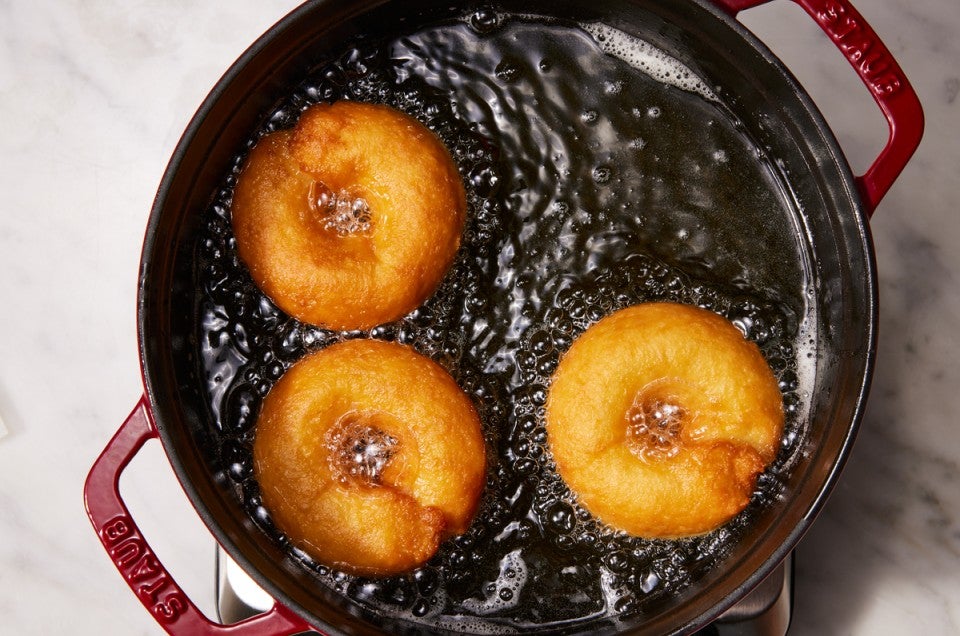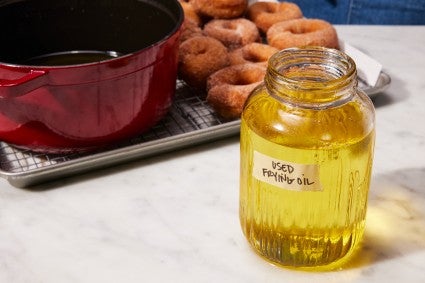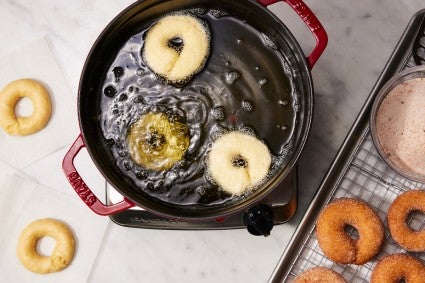How to reuse frying oil — and eventually discard it
Here's what to do with oil after frying.


Every May, I’m roped into working at the Greek Fest in my hometown. And despite the long days, scorching temperatures, and demanding customers, I always look forward to it. There’s only one reason why: fried loukoumades (Greek doughnuts), eaten piping hot, straight from the deep fryer.
That’s because freshly fried foods are simply incredible — they’re special enough to justify the hassle and time it takes to fill a vat of bubbling oil and carefully monitor sizzling dough for batch after batch. I mean, just look at these Classic French Crullers, or Claire Saffitz’s recipe for Frosted Sour Cream Cake Doughnuts. Who wouldn’t want that? But no matter how worthwhile the results, there’s no avoiding the leftovers: used frying oil, waiting to be dealt with.
But don’t let that stop you from frying at home! Here’s what to do with your leftover frying oil.

This is one of the most common frying questions new bakers ask. The good news is that the answer is yes! Frying oil has a longer lifespan than people realize — it can be used several times before you need to dispose of it. Reusing oil is the best way to reduce the waste (and cost) of frying.
To reuse frying oil, you simply need to strain it and store in a lidded container in a cool, dark place. Once you’re done frying, let the oil cool completely in the frying vessel. Once it’s cooled, strain it — ideally using a cheesecloth set in a fine mesh strainer, but just using a strainer by itself will work — into a clean vessel, like a glass jar or the original container it came in. It’s helpful to use a funnel here.
(Note: J. Kenji Lopez-Alt recommends this innovative gelatin clarification technique to clean used frying oil and extend its shelf life. I haven’t tried it yet, but I will next time I fry!)
Next, label the container. It’s helpful to include the date, what the frying oil was used for (ex. “doughnut frying oil”), and the number of times it has been used. Then store in a cool, dark place until ready to reuse.

Just remember that frying oil takes on the flavor of whatever it originally fried. Keep this in mind for future frying projects: If you used oil to fry fish, it probably won’t be good for frying crullers next (but you can go in reverse — cruller oil would be just fine for frying something savory).
Frying oil can be reused anywhere from two times to up to eight times — it all depends on the type of oil, what you’re frying in it, how well you’ve strained it, and more. There’s no hard and fast rule for when oil is no longer suitable for frying; instead, pay attention to your oil and detect any changes. If it’s become dark or dirty; if it’s smoking before it reaches frying temperature or foaming at the top; or if it’s taken on a different smell (besides whatever foods you’ve fried in it) that is rancid or musty, then it’s probably time to dispose of it.

Eventually, frying oil hits a point at which it can no longer be used. When this happens, it’s time to dispose of it, which can be difficult.
First things first: Do not pour it down your sink drain. The oil can congeal and clump, clogging your pipes and leading to a plumbing disaster.
Here are your options:
Solidify it, then trash it: There’s a product called FryAway that will solidify your oil into a block that can be tossed straight into the trash can. Magic! Simply sprinkle it over the cooled used oil, let it solidify, then throw away. (Heads up: At King Arthur, we only recommend the products that we, as bakers, truly love. When you buy through external links on our site, we may earn an affiliate commission.)
Transfer it to a closed container, then toss it: Alternately, you can pour your oil into a sealable disposable container (like the bottle it originally came in), close tightly, and throw it away.
Recycle it: Depending on where you live, you may be able to recycle your used oil. Use this handy navigator from Earth 911 to search for recycling drop-offs near you, or check with local services.
Feeling confident enough to start frying? We’ve got all the recipes you need, including Yeast-Raised Doughnuts, Old-Fashioned Cake Doughnuts, Milk Bread Doughnuts, and Classic French Crullers. And for tips for success, see our previous post: How to fry without fear.
Cover photo by Rick Holbrook; food styling by Kaitlin Wayne.


